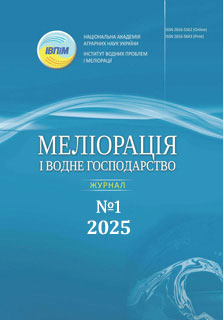IDENTIFICATION METHOD FOR THE LEVEL OF ENVIRONMENTAL SAFETY OF WATER BODIES
Abstract
A method for identifying the environmental safety of water bodies under conditions of uncertainty has been developed using systems analysis methods and a multicriteria approach. Improving the adequacy of identification involves searching for a more suitable criterion and using multiple criteria that comprehensively describe the goal of identifying the environmental safety level of water bodies and complement each other. The determination of environmental safety in the context of the requirements of the Water Code of Ukraine should be structured according to integrated criteria. The proposed identification method uses techniques for calculating scores of various factors that characterize the components of specific criteria. The objectivity of the identification process is ensured by using criteria that provide a sufficiently complete chain of assessment features of threats. The identification procedure is based on multicriteria evaluation approaches with subsequent aggregation into an integral index that defines the water body's environmental safety level. During the identification procedure, the values of indicators and indices of relevant characteristics are mapped to corresponding evaluation scales. The arguments of the target identification function, which are features of the evaluation factors according to their respective criteria components, are expressed as dimensionless scores. The identification problem for natural or artificial objects under uncertainty is solved using systems analysis methods and a multicriteria approach, and it is reduced to comparing the resulting scores and ranking them by a set of partial or integral criteria (index). The use of the Analytic Hierarchy Process to justify the contribution of comprehensive components to assessing the environmental safety level of Ukraine's water bodies is a key element that made it possible to select the most appropriate assessment methodology.
References
2. Ming, D., Yaxin, S., & Guiqiu, L. (2019). Optimized urban water security regulation schemes driven by industrial development pattern. Water Policy, 21 (3), 676-691. DOI: https://doi.org/10.2166/wp.2019.198
3. Gerlak, A. K., House-Peters, L., Varady, R. G., Albrecht, T., Zúñiga-Terán, A., de Grenade, R. R., & Scott, C. A. (2018). Water security: A review of place-based research. Environmental Science & Policy, 82, 79–89. https://doi.org/10.1016/j.envsci.2018.01.009
4. Linstone, H. A., & Turoff, M. (Eds.). (1975). The Delphi method: Techniques and applications. Reading, MA: Addison-Wesley.
5. Saaty, T. L. (2009). Mathematical principles of decision making (Principia Mathematica Decernendi). Pittsburgh, PA: RWS Publications. ISBN 1-888603-10-0
6. Bondar, O. I., Tarariko, O. G., & Varlamov, E. M. (2006). Vprovadzhennia yevropeiskykh standartiv i normatyviv u derzhavnu systemu monitorynhu dovkillia Ukrainy [Implementation of European standards and norms in the State Environmental Monitoring System of Ukraine]. Kyiv: Inres. [in Ukrainian]
7. Cabinet of Ministers of Ukraine. (2018, September 19). Postanova Pro zatverdzhennia Poriadku zdiisnennia derzhavnoho monitorynhu vod №758 [Resolution on the Procedure for State Water Monitoring, No. 758]. Uriadovyi Kurier, № 185. https://zakon.rada.gov.ua/laws/show/758-2018-%D0%BF#Text [in Ukrainian]
8. Chumachenko, S. M., Dudkin, O. V., Korzhnev, M. M., & Yakovlev, E. O. (2003). Metodychni aspekty otsinky i ranzhuvannia zahroz dlia bioriznomanittia v Ukraini [Methodological aspects of assessing and ranking threats to biodiversity in Ukraine]. Ekolohiya i resursy, Zb. nauk. prats. UINSiR RNBOU, 7, 77–86. [in Ukrainian]
9. Yatsiuk, M. V. (2025). Rozvytok naukovykh zasad otsiniuvannia vodnoi bezpeky Ukrainy yak skladovoi ekolohichnoi bezpeky [Development of scientific foundations for assessing water security of Ukraine as a component of environmental security] (Doctoral dissertation). Kyiv. [in Ukrainian]
10. Jensen, O., & Wu, H. (2018). Urban water security indicators: Development and pilot. Environmental Science & Policy, 83, 33-45. https://doi.org/10.1016/j.envsci.2018.02.003
11. Ginkel, K. C. H., Hoekstra, A. Y., Buurman, J., & Hogeboom, R. J. (2018). Urban water security dashboard: Systems approach to characterizing the water security of cities. Journal of Water Resources Planning and Management, 144(12), 04018072. https://doi.org/10.1061/(ASCE)WR.1943-5452.0000997
12. Lisichenko, H. V., Khmil, H. A., & Barbashev, S. V. (2011). Metodolohiia otsiniuvannia ekolohichnykh ryzykiv [Methodology for environmental risk assessment]. Odesa: Astroprynt. [in Ukrainian].
13. Rybalova, O. V. (2011). Kompleksnyi pidkhid do vyznachennia ekolohichnoho stanu baseiniv malykh richok [An integrated approach to determining the ecological status of small river basins]. Problemy okhorony navkolyshnoho pryrodnoho seredovyshcha ta tekhnohennoi bezpeky, Zbirnyk naukovykh prats UkrNDIEP, (33), 88–97. [in Ukrainian]
14. Pashchenko, O. M., & Hoshtynar, S. L. (2022). Mizhnarodno-pravovi zasady harantuvannia vodnoi bezpeky pid chas voiennykh konfliktiv. [International legal principles for guaranteeing water safety during military conflicts]. ENVIRONMENTAL LAW, (3-4), 57–62. https://doi.org/10.37687/2413-7189.2022.3-4-4.12 [in Ukrainian]


